Quilting fabric is the essential ingredient in any quilt-making endeavor. From vibrant prints to subtle solids, the options are endless, but understanding the intricacies of each fabric type is crucial for creating stunning quilts that stand the test of time.
Let’s embark on a journey through the colorful landscape of quilting fabric, where every thread tells a tale of craftsmanship and imagination.
What is Quilting Fabric?
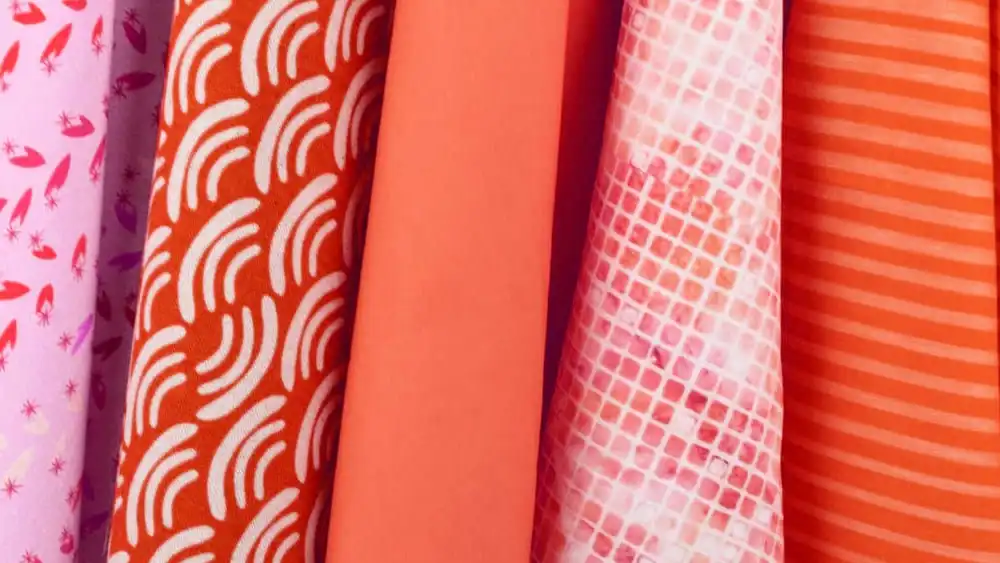
What are quilting fabrics?
Quilting fabric refers to the specialized type of fabric used in quilting, a traditional craft of sewing together layers of fabric to create a padded, decorative textile. This fabric serves as the canvas for the quilt, dictating its appearance, texture, and durability.
Quilting fabric comes in various types, each offering unique characteristics suited for different quilting projects. From classic cotton to luxurious silk, the options are diverse, allowing quilters to express their creativity in myriad ways.
Choosing the right quilting fabric is essential for achieving the desired look and feel of the finished quilt, making it an integral aspect of the quilting process.
What is Quilting Fabric Made of?
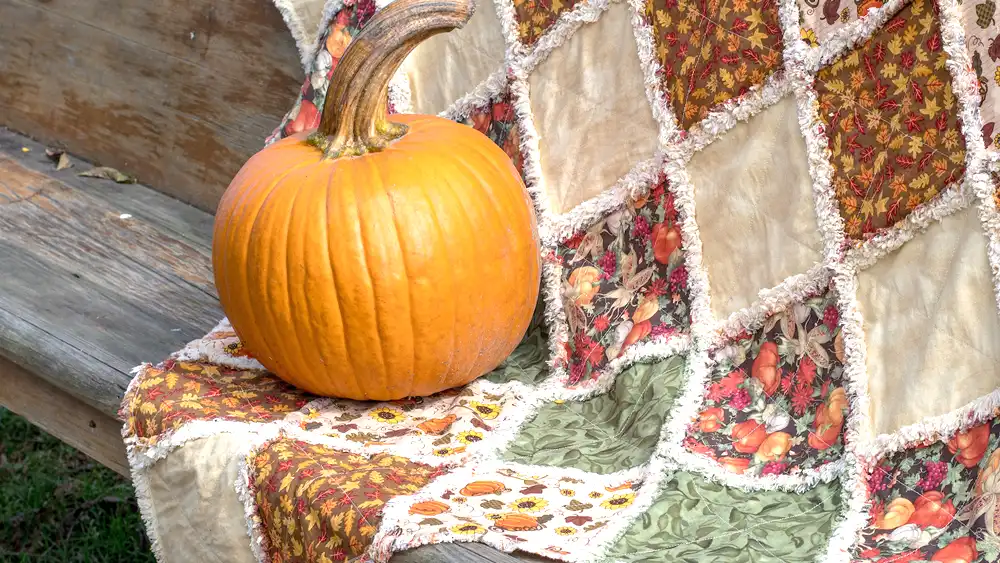
Quilting fabric is predominantly made from 100% cotton, specifically a high-quality, medium-weight cotton known as “quilting cotton.” This type of cotton is favored for its tightly woven plain weave, which makes it durable, stable, and easy to work with for precise cutting and sewing. It holds its shape well, is less prone to fraying, and maintains vibrant colors over time.
While cotton is the standard, other materials can also be incorporated, sometimes blended with cotton or used for specific effects.
Common materials used in quilting fabric include:
- Polyester: A synthetic option that is durable and resistant to shrinking and wrinkling, though often not as soft or breathable as cotton.
- 100% Cotton (Quilting Cotton): The most popular choice, known for its softness, breathability, durability, and ease of handling.
- Batiks: Often made from cotton, these fabrics are created using a specialized wax-resist dyeing process, resulting in unique and vibrant patterns. They typically have a higher thread count than regular quilting cotton.
- Flannel: A soft, brushed cotton fabric that provides warmth and a cozy feel, often used for baby quilts or warmer projects.
- Linen: While a bit more challenging to work with due to its open weave and tendency to fray, linen offers a beautiful texture and becomes softer with age and washing.
- Cotton/Linen Blends: These blends combine the best qualities of both fibers, offering texture and stability.
- Wool: Less common but used for its excellent insulation properties.
- Voile: A lightweight, silky cotton with a very high thread count and tighter weave, sometimes used for lighter quilts or quilt backs.
What Kind of Fabric is Used for Quilting?

Quilting fabric comes in a wide range of options, but there are a few key characteristics that make certain fabrics particularly well-suited for quilting:
Cotton: This is the most popular choice for quilting fabric. Cotton is breathable, soft, and easy to work with. It also holds color and prints exceptionally well, which is crucial for creating visually appealing quilts. Quilting cotton typically has a tight weave, providing stability and durability to the finished quilt.
Cotton Blends: These fabrics combine cotton with other fibers like polyester. Blends offer some of the benefits of cotton, such as softness and color retention, while also providing added features like wrinkle resistance and increased durability.
Batiks: Batik fabric is made using a wax-resist dyeing technique. It results in vibrant colors and unique patterns that are often used in quilting to add visual interest. Batiks are typically made from cotton and have a slightly heavier feel compared to traditional quilting cotton.
Flannel: Flannel is a soft, brushed fabric often associated with warmth and coziness. It’s commonly used for quilts that are meant to be extra snuggly, like baby quilts or winter quilts. Flannel quilts have a soft, plush texture that can be especially comforting.
Silk: Silk is a luxurious fabric that adds elegance and sheen to quilts. While less common than cotton, silk can be used for special quilting projects where a touch of luxury is desired. Silk quilts have a beautiful drape and a smooth, lustrous surface.
Wool: Wool fabric provides warmth and texture to quilts. Wool quilts are often made using wool batting, which offers excellent insulation without adding much bulk. Wool fabrics can be used as both quilt top and backing, adding depth and interest to the finished quilt.
Ultimately, the choice of fabric for quilting depends on factors such as the desired look and feel of the quilt, its intended use, and personal preference. Experimenting with different types of fabric can lead to exciting and unique quilting projects!
Benefits of Quilt Fabric
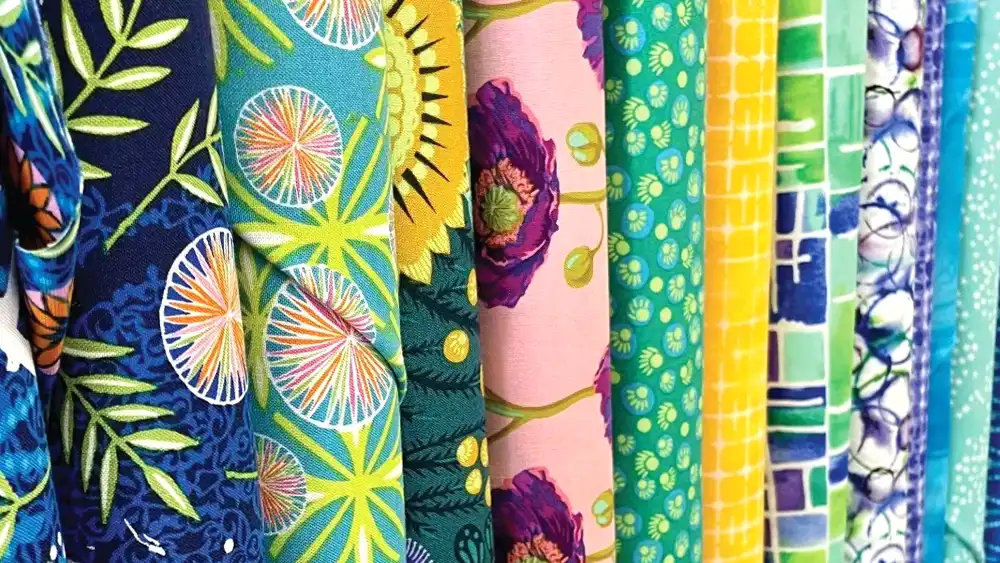
Quilt fabric offers several benefits that make it well-suited for quilting projects:
Durability: Quilt fabric is designed to withstand frequent handling, sewing, washing, and wear. It’s made from sturdy materials like cotton or polyester, which ensure that quilts remain intact and retain their beauty over time.
Variety: Quilt fabric comes in a wide range of colors, prints, and textures, allowing quilters to unleash their creativity and design unique quilts. From traditional florals to modern geometrics, there’s a fabric to suit every style and preference.
Ease of Sewing: Quilt fabric is typically woven with a tight, stable weave, making it easy to sew and piece together accurately. Whether hand-sewing or using a sewing machine, quilters can work with quilt fabric confidently, knowing that it will hold up well during the quilting process.
Colorfastness: Quality quilt fabric is dyed using methods that ensure long-lasting color retention. This means that quilts made from quilt fabric will maintain their vibrant colors even after multiple washes, preserving the beauty of the quilt for years to come.
Breathability: Fabrics like cotton are naturally breathable, allowing air to circulate through the quilt and providing comfort to the user. This is especially important for bed quilts, where breathability contributes to a comfortable sleeping environment.
Versatility: Quilt fabric can be used for a variety of quilting projects, from intricate pieced quilts to simple patchwork designs. It can also be combined with other materials like batting and backing fabric to create quilts of different thicknesses and textures.
Accessibility: Quilt fabric is widely available at fabric stores, online retailers, and quilting shops, making it easily accessible to quilters of all skill levels. With so many options to choose from, quilters can find the perfect fabric for their projects with ease.
Difference Between Quilting Fabric and Regular Fabric
While both quilting fabric and “regular” fabric (often referring to apparel or general-purpose cottons) are woven textiles, they are designed with different end uses in mind, leading to distinct characteristics. Quilting fabric is specifically engineered for piecing, cutting, and stitching into durable, long-lasting quilts.

While both quilting fabric and “regular” fabric (often referring to apparel or general-purpose cottons) are woven textiles, they are designed with different end uses in mind, leading to distinct characteristics. Quilting fabric is specifically engineered for piecing, cutting, and stitching into durable, long-lasting quilts.
Here are the key differences:
Weave and Thread Count:
- Quilting Fabric: Typically has a tighter, denser weave and a higher thread count (often 60-75 threads per inch or more). This provides stability, minimizes fraying, and ensures it holds its shape during the intricate piecing process.
- Regular Fabric: Can have a looser weave and a wider range of thread counts, depending on its intended use. Apparel fabrics, for example, might prioritize drape and softness over structural stability.
Weight and Drape:
- Quilting Fabric: Is generally a medium weight, firm cotton that has minimal drape. This stiffness is crucial for precise cutting and sewing of small pieces.
- Regular Fabric: Varies greatly in weight and can be very lightweight and drapey (like cotton voile or lawn) or heavier (like denim). The drape is often a primary consideration for clothing.
Fiber Content and Durability:
- Quilting Fabric: Predominantly 100% cotton, chosen for its stability, breathability, and ability to hold vibrant dyes. It’s designed to withstand repeated washing and years of use.
- Regular Fabric: Can be made from a vast array of fibers (cotton, silk, wool, polyester, rayon, blends, etc.) and is often selected for comfort, specific fashion trends, or particular performance needs, which may not always prioritize extreme longevity.
- Quilting Fabric: Typically comes in a standard width of 44 inches (around 115 cm).
- Regular Fabric: Often wider, ranging from 44 to 60 inches or more, to accommodate garment patterns with fewer seams.
Print Quality and Colorfastness:
- Quilting Fabric: Known for its high-quality printing, ensuring crisp designs and good colorfastness even after washing.
- Regular Fabric: Print quality and colorfastness can vary significantly depending on the manufacturer and price point.
Different Types of Quilting Fabric
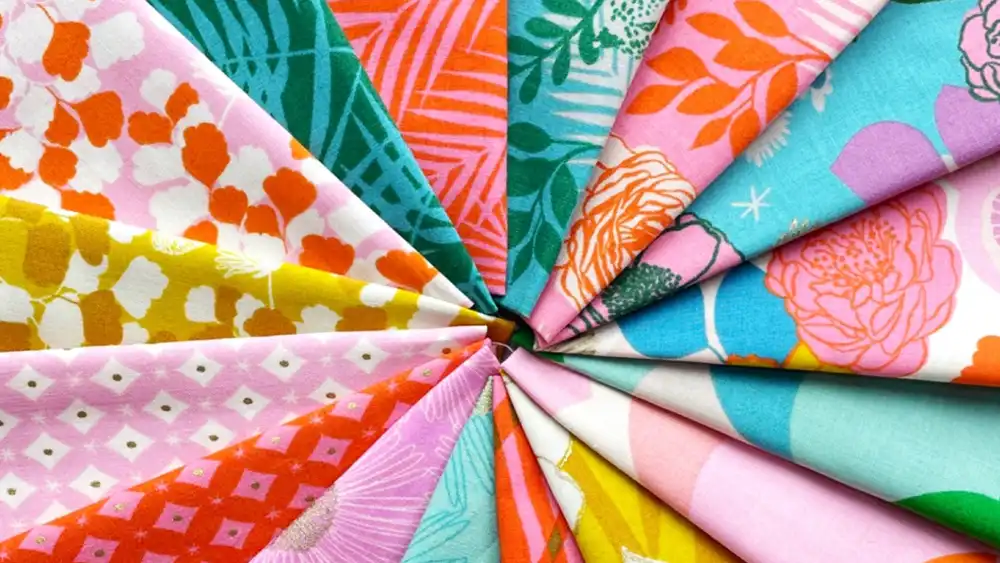
Cotton Fabric:
Cotton reigns supreme in the world of quilting fabric for its durability, breathability, and versatility. Its smooth texture and wide array of prints make it a favorite among quilters of all skill levels.
Batik Fabric:
Batik fabric, with its intricate designs and vibrant colors, adds a touch of exoticism to quilts. Originating from Indonesia, batik fabric is characterized by its wax-resist dyeing technique, resulting in stunning, one-of-a-kind patterns.
Linen Fabric:
Linen fabric brings an understated elegance to quilts with its natural texture and timeless appeal. While less commonly used than cotton, linen’s durability and distinctive look make it a prized choice for certain quilting projects.
Flannel Fabric:
Ideal for cozy, winter quilts, flannel fabric offers warmth and softness like no other. Its brushed surface lends a comforting feel, making it perfect for quilts meant to snuggle under during chilly nights.
Silk Fabric:
Luxurious and lustrous, silk fabric adds a touch of opulence to quilts. While not as commonly used as other fabrics due to its delicate nature, silk can elevate a quilt into a work of art, shimmering with elegance.
What are the Types of Quilting Cotton?
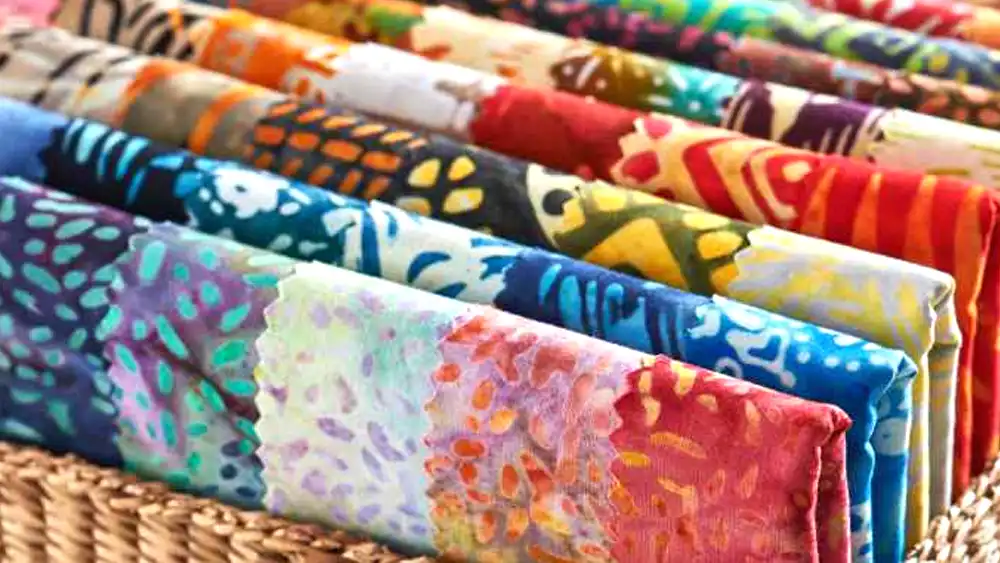
There are several types of quilting cotton available, each offering unique qualities suited to different quilting projects.
Some common types include:
- Printed Quilting Cotton: This is the most commonly used type of quilting cotton. It comes in a wide range of prints and patterns, from florals and geometrics to novelty prints and seasonal motifs. Printed quilting cotton is versatile and perfect for creating visually striking quilts.
- Solid Quilting Cotton: Solid-colored quilting cotton has no printed design or pattern, making it ideal for showcasing intricate piecing and quilting techniques. Solids come in a vast array of colors, allowing quilters to create bold, monochromatic designs or subtle color gradients in their quilts.
- Blender Quilting Cotton: Blender fabrics are subtle prints or textures that complement the main prints or solids in a quilt. They often feature small-scale motifs or tonal patterns in neutral or coordinating colors. Blender fabrics add depth and cohesion to quilt designs without overpowering the main focal points.
- Batik Quilting Cotton: Batik fabric is made using a wax-resist dyeing technique, resulting in vibrant colors and unique, marbled patterns. Batiks are often used in quilting to add visual interest and texture to quilts. They come in a variety of colors and designs, ranging from traditional to contemporary.
- Hand-Dyed Quilting Cotton: Hand-dyed fabrics are individually dyed by artisans, resulting in one-of-a-kind colors and patterns. These fabrics often have a rich, variegated appearance that adds depth and character to quilts. Hand-dyed quilting cotton is prized for its uniqueness and can elevate the look of a quilt.
- Specialty Quilting Cotton: Specialty quilting cotton encompasses a wide range of fabrics designed specifically for quilting. This includes fabrics with metallic accents, flannels for extra warmth, organic cottons, and eco-friendly options. Specialty quilting cottons cater to different preferences and needs within the quilting community.
Each type of quilting cotton offers its own advantages and can be used creatively to achieve different effects in quilting projects. Quilters often enjoy experimenting with various types of fabric to add texture, color, and visual interest to their quilts.
Factors to Consider When Choosing Quilting Fabric
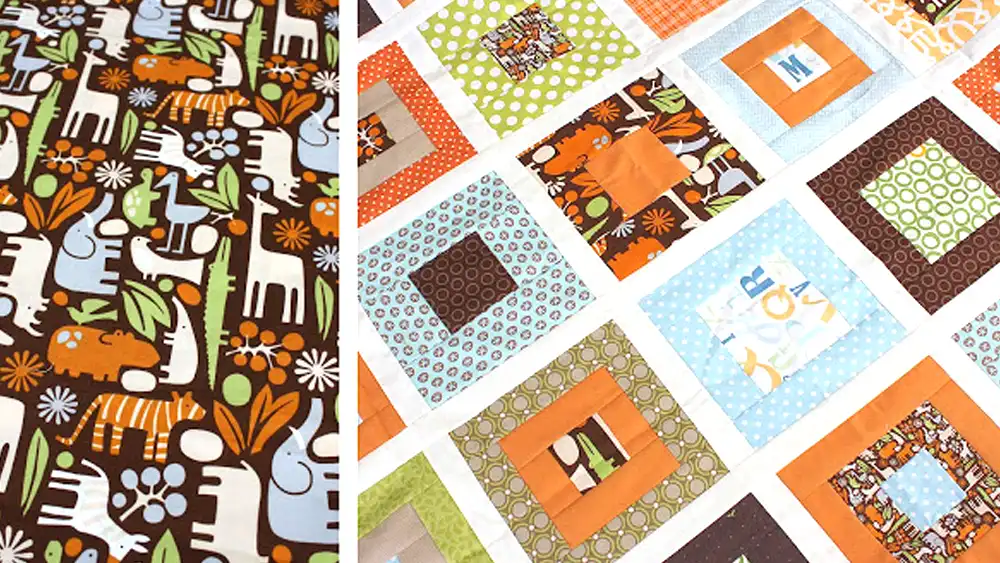
Color and Print Selection:
The color palette and print motifs of quilting fabric play a significant role in the overall aesthetic of a quilt. Consider the theme and mood of your project when selecting fabrics to ensure harmony and cohesion.
Fabric Quality:
Opt for high-quality fabrics that are tightly woven and colorfast to ensure longevity and durability in your quilts. Cheaper fabrics may save you money initially but can compromise the integrity of your quilt in the long run.
Fabric Care:
Different fabrics require different care instructions, so be sure to check the manufacturer’s recommendations before washing or ironing your quilting fabric. Proper care will preserve the beauty and lifespan of your quilts for generations to come.
What is the Width of Quilting Cotton?
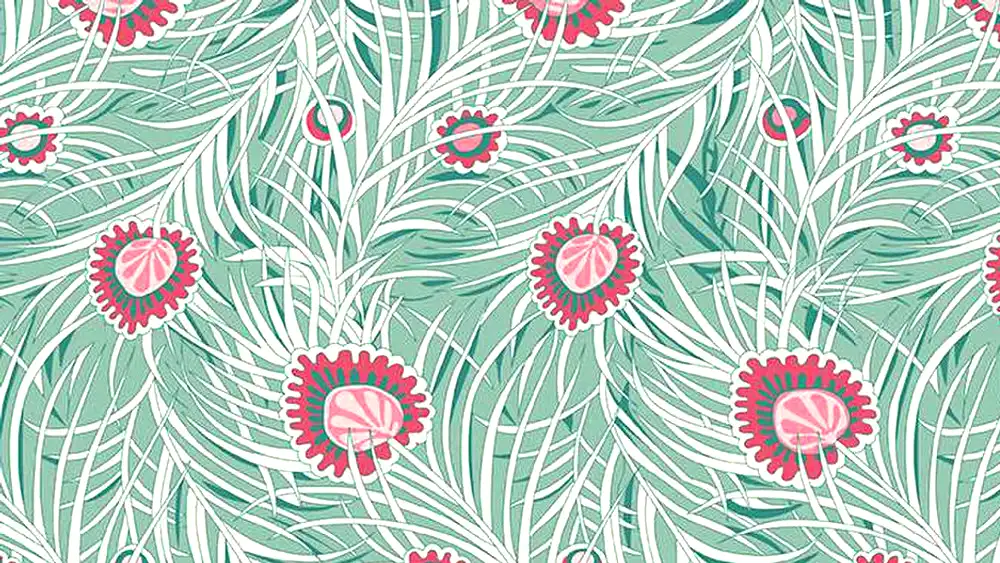
Let’s delve deeper into the various types of quilting cotton:
- Printed Quilting Cotton: This type of quilting cotton is adorned with a vast array of printed designs, ranging from traditional florals and geometrics to modern abstracts and novelty prints. Printed cottons are versatile and widely available, making them a popular choice for quilters of all levels. They offer endless possibilities for creating visually stunning quilts with vibrant colors and intricate patterns.
- Solid Quilting Cotton: Solid-colored quilting cottons are devoid of any prints or patterns, offering a clean and uniform look. Solids come in an extensive palette of colors, allowing quilters to create bold, monochromatic designs or subtle color gradients in their quilts. Solid fabrics are often used as background or accent fabrics to highlight piecing and quilting techniques.
- Blender Quilting Cotton: Blender fabrics are subtle prints or textures that seamlessly blend with other fabrics in a quilt. These fabrics typically feature small-scale motifs, tonal patterns, or textured designs in neutral or coordinating colors. Blender fabrics help unify the overall look of a quilt by providing cohesion between different prints and solids.
- Batik Quilting Cotton: Batik fabric is created using a unique wax-resist dyeing technique, resulting in intricate patterns and vibrant colors. Batiks are characterized by their marbled or mottled appearance, which adds depth and texture to quilts. These fabrics come in a wide range of colors and designs, from traditional Indonesian motifs to contemporary abstract patterns.
- Hand-Dyed Quilting Cotton: Hand-dyed fabrics are individually dyed by artisans, resulting in one-of-a-kind colors and patterns. These fabrics often feature rich, variegated hues and subtle gradations, adding visual interest and depth to quilts. Hand-dyed cottons are prized for their uniqueness and can elevate the aesthetic of a quilt.
- Specialty Quilting Cotton: Specialty fabrics cater to specific preferences and needs within the quilting community. This category includes fabrics with metallic accents, flannels for extra warmth, organic cottons, and eco-friendly options. Specialty quilting cottons offer quilters a diverse range of choices to suit their individual projects and preferences.
Understanding the different types of quilting cotton allows quilters to select fabrics that best complement their designs and achieve the desired aesthetic for their quilts.
Experimenting with various fabrics can lead to exciting and unique quilting creations!
What Does WOF Stand for in Quilting?
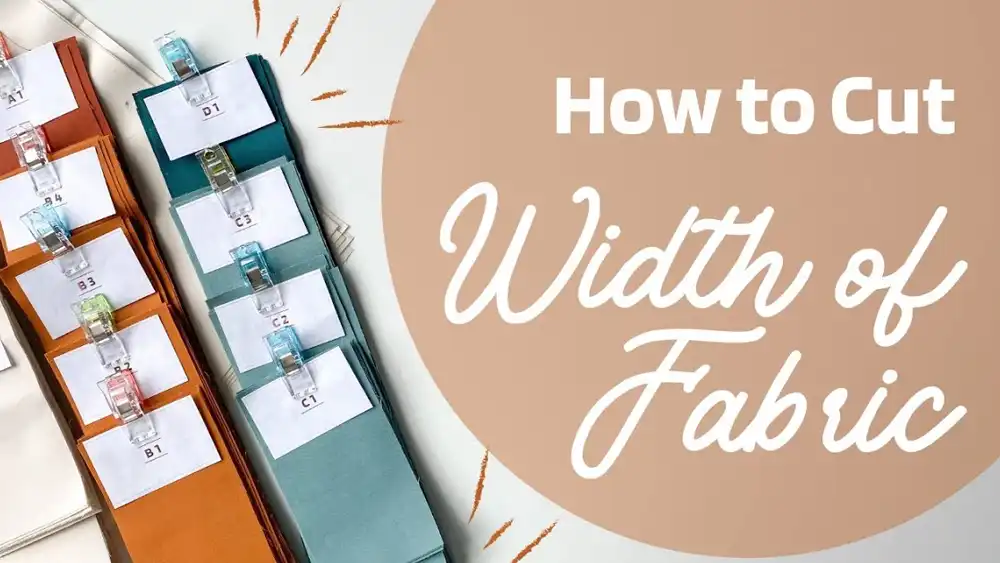
In quilting, “WOF” is an acronym that stands for Width of Fabric. This term is frequently used in quilting patterns and cutting instructions to indicate that a piece of fabric should be cut across the entire usable width of the material, from one selvage to the other.
The standard usable width of most quilting cottons is approximately 42 inches, although this can vary slightly depending on the manufacturer and specific fabric line. Patterns will often instruct quilters to “Cut a 2 ½” x WOF strip,” for example.
This means you would cut a strip that is 2 ½ inches wide and extends all the way across the fabric, typically from one selvage edge to the other (excluding the selvage itself, which is the tightly woven finished edge of the fabric). These WOF strips are then often “sub-cut” into smaller pieces like squares or rectangles for the quilt blocks.
Conclusion
Quilting fabric is more than just material; it’s the foundation of every beautiful quilt. Understanding its properties, from fiber content to thread count, ensures your projects are not only stunning but also durable.
Choosing the right fabric elevates your quilting from a craft to an art form, impacting drape, texture, and overall aesthetic. This guide empowers you to make informed decisions for all your creative endeavors.
For high-quality materials, consider getting wholesale quilting fabric from Fanda Fabrics, ensuring your quilts benefit from the best possible start.
